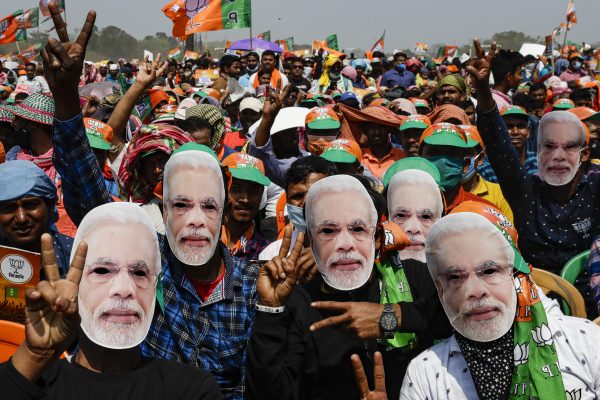
India’s Election Commission (EC) has sounded the poll bugle, marking the formal start of the electoral battle for control of assemblies in five states – the northern states of Uttar Pradesh, Punjab and Uttarakhand; Manipur in the Northeast, and Goa in western India.
On January 8, it announced voting dates in these states. Uttar Pradesh will vote in seven phases between February 10 and March 7; Manipur on February 27 and March 3; and Punjab, Goa, and Uttarakhand on February 14.
Justifying its decision to hold elections amid a third COVID-19 wave driven by the Omicron variant, the Election Commission said that holding elections on time is the “essence of maintaining democratic governance.” It is taking steps to ensure safety amid the pandemic, it said, announcing a ban on physical rallies and meetings till January 15. The decision according to the evolving situation on the ground.
Should the ban on rallies be extended, political parties will have to rely on digital campaigns. This puts the Bharatiya Janata Party (BJP) at an advantage as the party has been using digital media in its campaigns since the 2014 general election. Other parties are way behind with regard to digital media infrastructure and skills.
It is the Election Commission’s responsibility to ensure that elections are free and fair and to provide a level playing field for all parties. However, many are already criticizing it for taking decisions that give some an unfair advantage.
The decision to hold multi-phase elections is one such decision. In multi-phase elections, campaigning often extends over several weeks – the 2019 parliamentary elections, for instance, were staggered over 39 days. Such campaigning is expensive and it is only parties that have deep pockets that can afford this.
The BJP is easily the most well-funded party. It cornered 76 percent of the total electoral bonds sold in the 2019-2020 financial year, NDTV reported, citing Election Commission data. The Congress was distant second, securing just 9 percent of the bonds sold.
With its overflowing coffers, the BJP will be able to sustain its campaign over several weeks. The smaller parties will fight the elections with a crippling disadvantage.
India needed staggered elections because of its large population. Besides, election-related violence was common; candidates were known to capture polling booths especially in north India. Importantly, several regions were insurgency-wracked and militants would call for poll boycotts and seek to disrupt voting. Massive security arrangements needed to be made to ensure safe voting. Troops needed to be ferried from one part of the country to another. Multi-phase elections made sense in this context.
However, use of electronic voting machines have reduced incidents of “booth capture” and better connectivity has facilitated faster troop movement across the country. Holding elections have become easier and the Election Commission must hold elections within a shorter span of time.
Critics point out that multi-phase elections are not necessarily more peaceful. West Bengal voted in an eight-phase election in March-April 2021. The multi-phased voting in the state did not prevent violence, former Chief Election Commission T Krishnamurthy pointed out.
Multi-phased elections make even less sense amid a pandemic. “Agonisingly staggered phases of voting” in last year’s assembly elections, held amid an “unprecedented situation of the pandemic,” called for elections that would have “been a quick affair, with limited campaigning,” an editorial in The Hindu said. “What happened was the opposite.”
Hundreds of election rallies where political leaders and supporters neither wore masks nor followed social distancing guidelines were among the reasons for the acceleration of the deadly COVID-19 second wave. One would have thought that the nightmarish experience with the second wave last year would have prompted the Election Commission to decide against elections stretched over a month. This was an avoidable risk.
With the announcement of the election schedule, a Model Conduct of Conduct aimed at ensuring a free and fair election kicks in. Among other things, it forbids incumbents from announcing policy decisions to sway voters and all politicians from contesting parties from making hate speeches.
Within 48 hours of the MCC coming into effect, BJP leaders began their anti-Muslim rants. “This fight is now 80 versus 20,” Adityanath said at a public event, suggesting in not so subtle terms that the electoral battle is one between Hindus, who make up around 80 percent of Uttar Pradesh’s population and Muslims, the 20 percent minority.
While opposition parties did criticize him—the Congress’ Digvijay Singh asserted that it breached the MCC, no party has registered a complaint with the Election Commission. If elections in recent years are any indication, then the body “is unlikely to provide any relief to them.” This was the case during the 2021 assembly elections when the Election Commission repeatedly let off BJP leaders who brazenly violated the code of conduct. Addition it is possible that the opposition parties in Uttar Pradesh are avoiding reacting to the BJP’s communal propaganda. Doing so, will allow the BJP to set the electoral agenda and thus hand it yet another advantage.
India’s Election Commission is supposed to be a referee. Over the decades, it had built a formidable reputation as an independent body and commanded public trust. That reputation, already tarnished, is in serious peril.
India State Assembly Elections: Where Is the Level Playing Field?
Source: Frappler

0 Comments